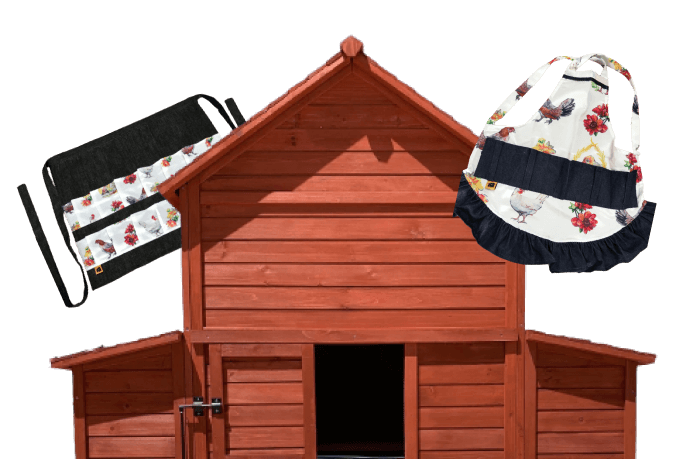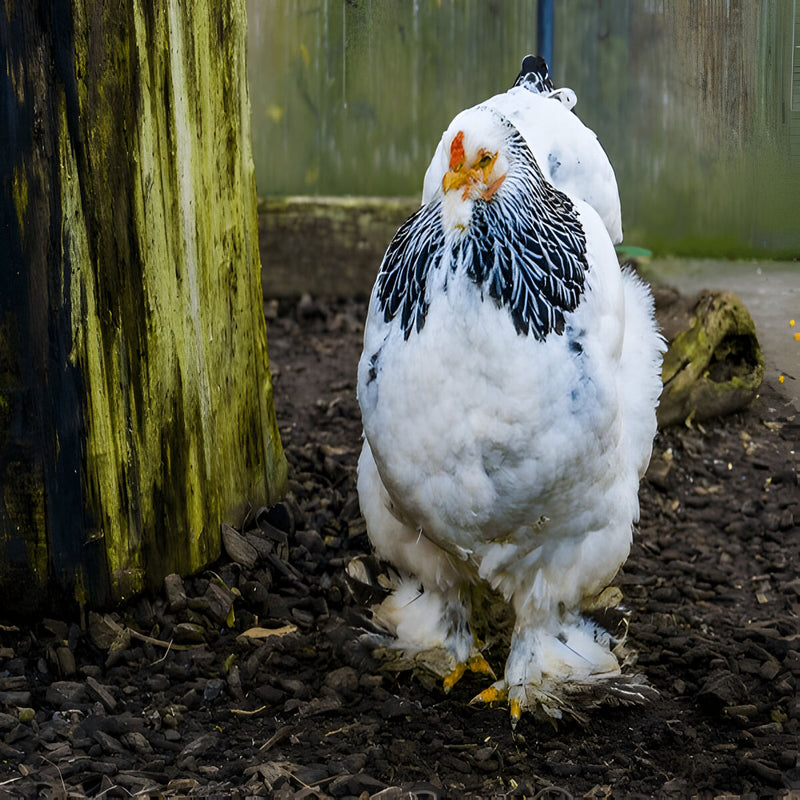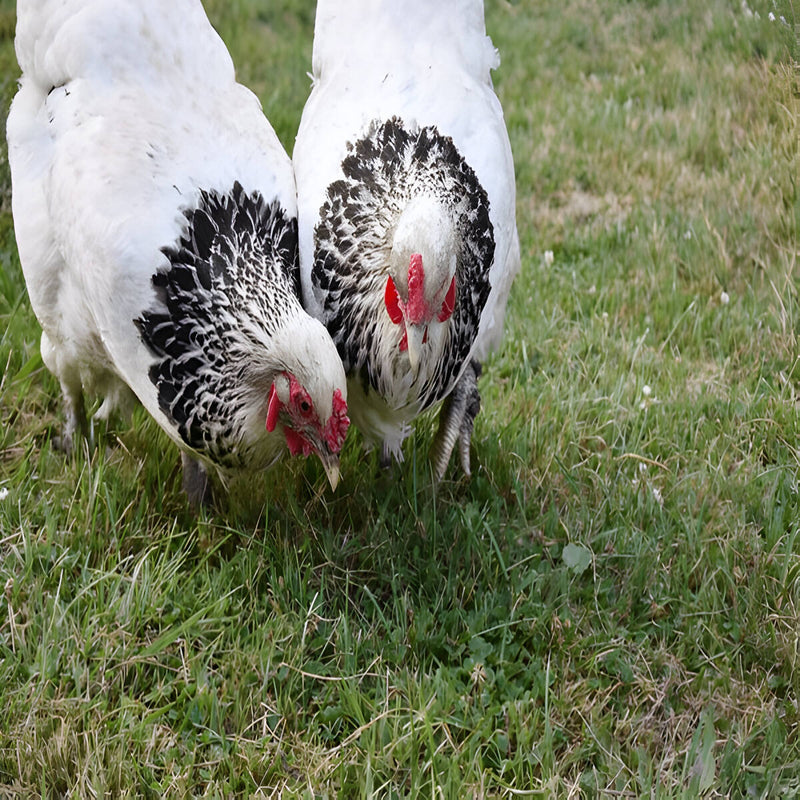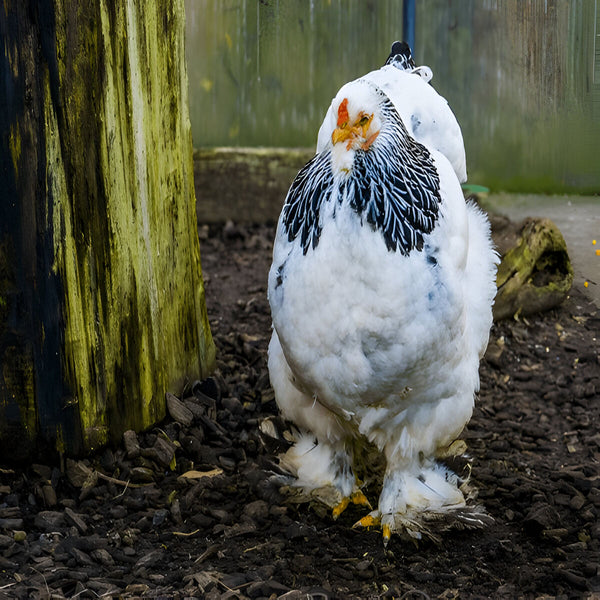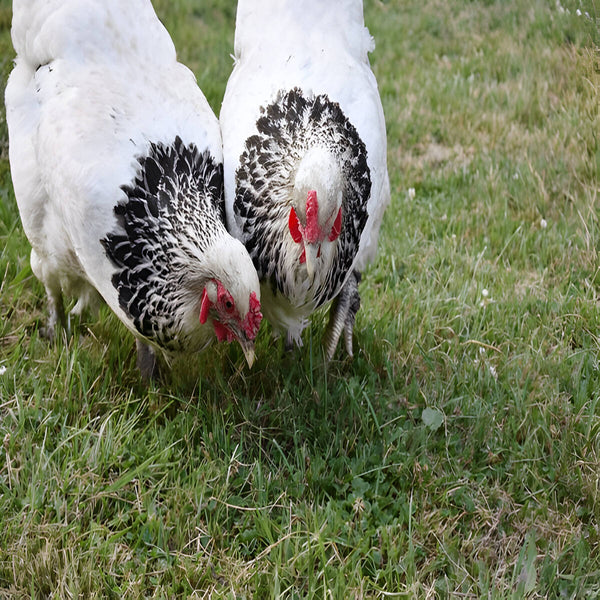-
Egg Size
Medium
-
Egg Quantity
Good (3/wk)
-
Egg Color
Brown
-
Cold Tolerance
Hardy In Winter
-
Heat Tolerance
Not Especially Heat Tolerant
-
Abundance
Common
-
Personality
Calm
-
Size
Large Fowl
-
Feathered feet
Yes
Light Brahma
Light Brahma Chicken
Originating in Asia and introduced to this country in the mid-1800s, Light Brahma chickens are renowned for their quiet, gentle nature and ease of handling. With their small pea combs, impressive size, and dense plumage, these birds are well-suited to cold climates.
They feature feathered legs, are reliable layers of brown eggs, and make excellent brood mothers, making them very child-friendly as pets. Their plumage is primarily white with black tail and neck feathers. Brahmas are notable for their large stature, with roosters reaching up to 12 pounds and hens approaching 10 pounds, making them a good choice for meat production.
These chickens are adaptable to various climates. Their substantial body and thick feathering provide excellent cold tolerance. During summer, they thrive with adequate shade and water. However, their feathered legs and feet can collect mud in rainy conditions and snow in winter, so it's important to monitor and clean their feet as necessary. The Chicken Coop Company offers production-type Light Brahma chickens rather than exhibition types.
Health and Care:
-
Hardy and Resilient: The Light Brahma is a hardy breed, capable of adapting to various climates. Their dense feathering makes them well-suited for colder environments, as they can withstand the chill better than many other chicken breeds. However, they can also tolerate warmer temperatures as long as they have access to shade and fresh water.
-
Disease Resistance: Brahmas, including the Light Brahma, are generally disease-resistant and robust. However, like all chickens, they can be susceptible to common poultry ailments such as mites, lice, and respiratory issues if their living conditions are not maintained properly. Regular cleaning, good ventilation, and proper nutrition are essential for keeping them healthy.
-
Low Maintenance: The Light Brahma is relatively low-maintenance in terms of care. They require basic care such as a clean, dry, and spacious living environment, along with a balanced diet and fresh water. Their friendly nature also makes them easy to manage compared to more temperamental breeds.

Egg Laying:
-
Moderate Egg Production: Light Brahma chickens are moderate layers, producing around 200-250 eggs annually. Their eggs are typically large and brown in color, making them a valuable addition to any flock. While they may not be the highest egg producers in terms of quantity, their large eggs make them a reliable source of high-quality eggs.
-
Year-Round Laying: Like many chickens, Light Brahmas can be affected by shorter daylight hours in winter, causing a decrease in egg production. However, with adequate lighting and care, they are generally reliable layers throughout the year.
-
Large Brown Eggs: The eggs they produce are large, brown, and consistent in size, which makes them popular for both home kitchens and small-scale egg production.
Temperament:
-
Gentle and Friendly: Light Brahmas are well-known for their calm and gentle temperament. They are very friendly, sociable, and non-aggressive, making them an excellent choice for families with children or beginner chicken keepers. They are easy to handle and are usually tolerant of human interaction.
-
Sociable: These chickens are social birds that enjoy the company of other chickens. They tend to get along well in a mixed-flock setting, as they are not dominant or territorial. They are also less likely to be bullied compared to other breeds, which can sometimes be a concern with larger chickens.
-
Laid-Back and Peaceful: Light Brahmas are calm, laid-back, and peaceful. They are not prone to flightiness or nervous behavior, which makes them a good choice for backyard flocks where space and tranquility are valued. They tend to be quiet, adding to their appeal in more suburban or urban environments.

Appearance:
-
Striking Plumage: The Light Brahma chicken is known for its elegant appearance. It has a beautiful, contrasting color pattern, with white feathers that are laced with dark markings on the edges, particularly on the tail and wings. The feathers have a soft, silky texture, which gives the bird an elegant and fluffy appearance.
-
Large Size: Light Brahmas are a large breed. Hens typically weigh around 8-9 pounds, while roosters can reach up to 10-12 pounds. Despite their large size, they are very gentle and not overly aggressive, making them suitable for smaller backyards or mixed flocks.
-
Feathered Legs and Feet: One of the most distinctive features of the Light Brahma is its feathered legs and feet. Their legs are covered in soft feathers that give them a unique and ornamental look, which also helps protect them from cold ground in winter.
- Single Comb and Wattles: Like many chicken breeds, the Light Brahma has a single comb, which is upright and red in color. The wattles and earlobes are also red, contrasting beautifully with their white feathers.
Frequently Asked Questions:
Light Brahma chickens are renowned for their hardiness and decent egg-laying abilities. These birds can produce up to 200 large, medium-brown eggs annually. They are particularly valued as winter layers, delivering the majority of their eggs from October to May.
Brahma chickens are distinctive for their size and calm temperament. Although hybrid breeds often have shorter lifespans, Brahmas can live between 4 to 7 years, with some reaching up to 10 years under optimal conditions.
Light Brahmas are known for their slower growth rate. They typically begin laying eggs around 6 to 7 months of age. This is later than many modern breeds, which usually start laying at 4 to 5 months.
Brahma chickens are generally known for their gentle nature, with low levels of aggression among roosters. This docility allows for more roosters to be kept together compared to other breeds. However, Brahma roosters may not be as proficient at mating as some other rooster breeds.
Light Brahma Facts
- Poultry Show Class: Asiatic Class
- Weights: Hen–9 1/2 lbs
- Rooster—12 lbs
- Pullet—-8 lbs
- Cockerel—–10 lbs
- Purpose and Type: Primary production, Egg Laying, Broody Mothers & Pet/Secondary meat source
- Egg Shell Color: Brown
- Egg Production: 180-240 eggs per year (estimates only)
- Egg Size: Medium-Large
- Temperament: Docile
- Gender Accuracy: 85-90%
- Fertility Percentage: 65-80%
- Broody: Setter
- Mating Ratio: 8 Females to 1 Male
- Roost Height: 2 to 4 feet
- Country of Origin: Asia
- APA: Yes, Recognized by the Standard of Perfection in 1874.
- TLC: Yes, Recovering Status, Considered a sustainable heritage chicken breed
- Breeder Farm Source: Poultry Breeding Farm has been developing our bloodline/strain of pure Light Brahma since 1979.
Notice: We do not sell items on Amazon or other websites.
